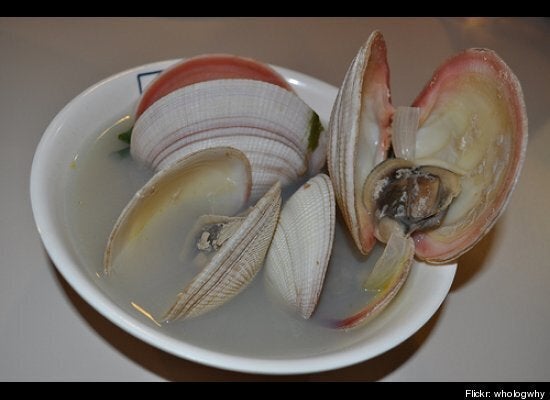Salmon seems to be the perfect food -- very tasty, high in protein and healthy Omega-3 fatty acids, and easy to prepare and cook. But as with every other overfished species in the sea, there simply aren't enough of them left in the wild to meet our growing demand. It seems that whenever humans really like a particular type of fish, that popularity guarantees a rapid decline in their population. In the Atlantic Ocean, wild salmon stocks have already been depleted and studies show that wild Pacific salmon stocks are also declining.
Humans have done this before with species like cod. Now the only way we can meet our voracious appetite for salmon is to farm them by "aquaculture." Amazingly, about 70 per cent of all the salmon we now eat are raised on fish farms. However, there are hidden costs of salmon farming that most consumers never see. Many people are not even aware that they are eating farmed salmon, let alone understand its many negative environmental impacts. I believe it's important for people to understand how what they eat is produced so they can make the best choices for their families and the environment.
Farmed salmon spend the majority of their lives in mesh net cages in the open ocean. Their waste and fecal matter flows freely into surrounding waters, often smothering the seafloor and the marine life there. A small salmon farm of 200,000 fish can produce as much fecal matter per year as a city of 62,000 people. But unlike cities and some land-based livestock farms, the waste from salmon farms is never contained or treated.
In addition to fecal matter, antibiotics and pesticides that are occasionally added into salmon feeds can also flow into surrounding waters and be consumed by wild salmon and other fish species that do not need to be medicated.
While salmon farms can do harm to any marine ecosystem where they are located, the most serious concerns arise on Canada's West Coast where the bulk of Canadian farmed salmon is produced. Ironically, salmon farms in British Columbia almost exclusively raise Atlantic salmon because these salmon grow better in crowded farm conditions.
Since Atlantic salmon are not native to the Pacific, when they escape from the mesh net pens they are an invasive species and can displace wild salmon species by reproducing and consuming their natural food supply. Between 1987 and 2008, over 1.5-million Atlantic salmon escaped into the Pacific Ocean from salmon farms in B.C. and thousands more continue to escape each year.
As water flows freely in and out of salmon pens, it also means that parasites, diseases and viruses can easily be transferred between wild and farmed populations. While salmon farmers claim to have control over the spread of diseases, indications are that they are not fully capable of controlling infections.
The biggest concern now is the possibility of farmed Atlantic salmon spreading a foreign Atlantic salmon disease known as ISA into wild Pacific salmon populations. The same Norwegian companies that operate in Canada have already spread ISA to Chile, nearly collapsing the entire salmon farming industry in the country. However, Chile does not have wild salmon. If ISA ever spreads into wild Pacific salmon populations in Canada, the results could be even more devastating for both the wild Pacific salmon stocks and marine ecosystems.
Wild Pacific salmon are simply too valuable to Canada and the entire coastal B.C. ecosystem to take any risks which could endanger this critical resource. Coincidentally, the same government department that is responsible for preserving wild salmon is also responsible for promoting farmed salmon. Since many of the farms are foreign owned, mainly by Norway, Canadians have an interest in what happens to our resources.
Thankfully, there is a solution to these problems: simply move open-ocean salmon farms onto land-based closed containment systems. The technology already exists, but the industry is reluctant to make this significant shift due to the massive, one-time capital outlay needed to convert. But some smaller-scale entrepreneurs are already proving that closed containment is working very well.
That said, however exciting the possibility of widespread use of land-based containment systems is, the biggest flaw of salmon farming remains: the use of large quantities of smaller, wild fish used to feed the farmed salmon.
The main reason carnivorous salmon are so nutritious is because they eat other fish packed full of nutrients. To produce one kilogram of farmed salmon, they must be fed around 1.2 to 3 kilograms of wild fish. As wild fish stocks continue to be depleted worldwide and we look to aquaculture as the future of seafood, the solution should never involve feeding farmed salmon a diet of wild fish that contributes to the depletion of wild fish stocks.
If we do insist on farming salmon in this country, let's do it in the most responsible manner: on land, in closed systems. Let's spread the word!
Alex Mifflin and brother Tyler Mifflin host the award-winning eco-adventure series, The Water Brothers, exploring the world's most important water stories. The second season airs Tuesdays at 7:30 p.m. from September 10 - October 22 on TVO and at www.thewaterbrothers.ca. Learn more about farmed salmon and its impacts in "Farmed and Dangerous," the next episode of The Water Brothers airing October 15.
